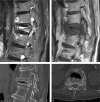Percutaneous Vertebral Augmentation Techniques in Osteoporotic and Traumatic Fractures
- PMID: 30402014
- PMCID: PMC6218258
- DOI: 10.1055/s-0038-1673639
Percutaneous Vertebral Augmentation Techniques in Osteoporotic and Traumatic Fractures
Abstract
Percutaneous vertebral augmentation/consolidation techniques are varied. These are vertebroplasty, kyphoplasty, and several methods with percutaneous introduction of an implant (associated or not with cement injection). They are proposed in painful osteoporotic vertebral fractures and traumatic fractures. The objectives are to consolidate the fracture and, if possible, to restore the height of the vertebral body to reduce vertebral and regional kyphosis. Stabilization of the fracture leads to a reduction in pain and thus restores the spinal support function as quickly as possible, which is particularly important in the elderly. The effectiveness of these interventions on fracture pain was challenged once by two randomized trials comparing vertebroplasty to a sham intervention. Since then, many other randomized studies in support of vertebroplasty efficacy have been published. International recommendations reserve vertebroplasty for medical treatment failures on pain, but earlier positioning may be debatable if the objective is to limit kyphotic deformity or even reexpand the vertebral body. Recent data suggest that in osteoporotic fracture, the degree of kyphosis reduction achieved by kyphoplasty and percutaneous implant techniques, compared with vertebroplasty, is not sufficient to justify the additional cost and the use of a somewhat longer and traumatic procedure. In young patients with acute traumatic fractures and a significant kyphotic angle, kyphoplasty and percutaneous implant techniques are preferred to vertebroplasty, as in these cases a deformity reduction has a significant positive impact on the clinical outcome.
Keywords: interventional radiology; kyphoplasty; vertebral augmentation techniques; vertebral fracture; vertebroplasty.
Figures











References
-
- Fechtenbaum J, Cropet C, Kolta S, Verdoncq B, Orcel P, Roux C. Reporting of vertebral fractures on spine X-rays. Osteoporos Int. 2005;16(12):1823–1826. - PubMed
-
- Lindsay R, Silverman S L, Cooper C et al.Risk of new vertebral fracture in the year following a fracture. JAMA. 2001;285(03):320–323. - PubMed
-
- Roux C, Fechtenbaum J, Kolta S, Said-Nahal R, Briot K, Benhamou C-L. Prospective assessment of thoracic kyphosis in postmenopausal women with osteoporosis. J Bone Miner Res. 2010;25(02):362–368. - PubMed
-
- Edidin A A, Ong K L, Lau E, Kurtz S M. Life expectancy following diagnosis of a vertebral compression fracture. Osteoporos Int. 2013;24(02):451–458. - PubMed
-
- Magerl F, Aebi M, Gertzbein S D, Harms J, Nazarian S. A comprehensive classification of thoracic and lumbar injuries. Eur Spine J. 1994;3(04):184–201. - PubMed

